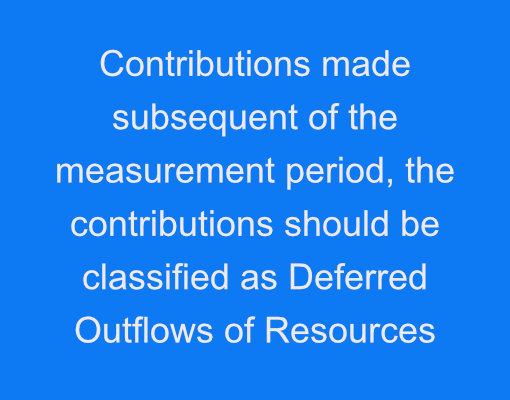Pensions for state and local governments are a benefit to attract industry workers and others to work and have a career in government. There are many types of pensions and this month’s topic will revolve around the accounting and reporting of cost-sharing employer pensions such as CalPERS or a County Pensions (i.e. SCERS, SJCERA). The accounting standard that provides guidance to state and local governments is GASB 68. GASB 68, Accounting and Financial Reporting for Pensions, replaced GASB 27 and requires governments to recognize the long-term obligation (aka how much is owed for having a pension) According to the Governmental Accounting Standards Board, this pronouncement enhances accountability and transparency through revised and new note disclosures and required supplementary information (RSI).
If you are a manager of a local government that provides pensions to its employees, you should have at minimum a high level understanding of how the accounting and reporting of pensions are made and why? There were three main reporting changes when GASB 68 came into effect on fiscal year beginning after June 15, 2014.
- Governments to record their proportionate share of the net pension liability (Assets in the pension minus the liability of the pension)
- Pension expense is not equal to the pension contributions made.
- Governments are required to include longer note disclosures regarding its pensions and additional supplemental information

GLOSSARY OF TERMS

Before we proceed let’s review a glossary of terms.
- Net pension liability – This is determined by the plan itself and is the difference between the plan assets and the plan liabilities
- Net pension asset – This is similar to the net pension liability, but in reverse. The plan assets exceed the plan liabilities
- Deferred outflows of resources – This is similar to a prepaid asset and is recorded when there are changes in proportionate share of contributions, changes in assumptions, when there are differences in projected and actual earnings, and changes in demographics.
- Deferred inflows of resources – This is similar to the deferred outflows of resources, but they are differences that are favorable meaning the changes ultimately will reduce the net pension liability.
- Pension expense – This is the difference between the net pension liability, deferred inflows of resources, and deferred outflows of resources.
- Special funding situation – A non-employer entity is legally responsible for some pension contributions.
- Measurement date – The Actuarial report date.
HOW DO YOU FIND THE INFORMATION?
Normally the pension plan needs an actuary to prepare the report used to enter the accounting entries. (GASB 68 allows for the measurement date to be no earlier than one year and one month prior to the local government’s fiscal year-end)

Some reports will include individual contributing entities and others pool all assets and liabilities and the local government needs to compute the net pension liability, deferred inflows, and deferred outflow of resources. For example, the San Joaquin County Retirement Association provides each individual local government that participates, but CalPERS pools all investments and liabilities and does not individually record each local government’s share of net pension liabilities.
If the actuarial report does provide a local government’s share of net pension liability, deferred inflows, and deferred outflow, take a look at the actuarial report and find your local government. These three accounts should be found in the report and you’ll need this to enter the accounting entries. Now each of these three accounts are complex and a detailed explanation is outside the scope of this white paper, but at a basic level, memorize the terms on page two to learn at a basic level what each of these accounts are. Next you’ll need to enter the pension expense. At the most basic level it is the difference between the net pension liability, deferred outflows, and deferred inflows. The pension expense is not the same amount as the contributions to local government made. More on that later.
If the actuarial report does not provide a local government’s share of net pension liability, you’ll need to compute your share of the net pension liability, deferred inflows, and deferred outflows. If you contribute to CalPERs, CalPERS has a wonderful excel worksheet tool to assist in the accounting entries. Simply click on this link to review the GASB 68 Employer Tool (June 30, 2018 Measurement Date Reports) (XLSX).

This tool is also used by some auditors to re-compute the GASB 68 entry for those clients that have CalPERS. Ask your auditor, if s/he uses this tool as part of her/his testing. If s/he does, then you can ask for a copy as this tool needs for you to enter FYE 2014 through the current year to figure out the accounting entries per GASB 68. You can also call our office if you need assistance using this tool.
WHAT ABOUT CONTRIBUTIONS?
If the total contributions made to the plan is different than the actuarial derived contribution amount, the local government should recognize the difference as an expense.
If the contributions are made subsequent of the measurement period, the contributions should be classified as Deferred Outflows of Resources.
If you receive contributions from another entity, these contributions should be classified as revenue and should not reduce the pension expense (GASB 68 paragraph 58).

RECOGNITION IN FINANCIAL STATEMENTS
There will be three main accounts in the statement of net position and one account in the statement of activities. These are (1) Net pension liability, (2) Deferred outflow of resources, (3) Deferred inflow of resources, and (4) Pension expense (Stmt of Activities). In the following few paragraphs we will discuss what each of these accounts entails and how they are accounted for.
(1) Net pension liability – Actuarially derived and accounts for the Total plan assets minus total plan liabilities
(2) Deferred outflows of resources – Classified directly under the Asset section of the financial statements. When there is a difference investment / demographic factors, assumption changes, investment return, and proportionate change to the total liability of the pension, and differences between actuarially derived contributions and actual contributions.
(3) Deferred inflows of resources – Classified directly under the liability section of the statement of net position. When the same type of changes are made but it benefits the government, these are classified as deferred inflows of resources.
(4) Pension expense – Classified as an expense to the statement of activities. The statement of activities does not have to break out this expense line item, but it does need to be found in the note disclosures.
NOTE DISCLOSURES
Note disclosures is one of three main changes that GASB 68 created. Governments are required to disclose the following:
- Significant assumptions and other inputs used to measure the total pension liability including the following
- Inflation
- Salary changes
- Dates of experience studies
- Discount rate applied and if the discount rate changed from the prior year
- Long-term expected rate of return and a brief description of how it was determined
- Asset allocation of plan assets
- Net pension liability assumed at 1% less and 1% greater than the used discount rate

Other Information
- The amount of pension expense
- The amount of contributions subsequent of measurement date
- The entity’s balances of deferred outflows of resources and deferred inflows of resources classified as follows:
- Differences between expected and actual experience in the measurement of the total pension liability
- Changes of assumptions or other inputs
- Net difference between projected and actual earnings on pension plan investments
- Changes in the employer’s proportion and differences between the employer’s contributions (other than those to separately finance specific liabilities of the individual employer to the pension plan) and the employer’s proportionate share of contributions
There is also a supplemental report that’s mandatory to report on pension. This report is a ten-year schedule presenting the following information:
I. The employer’s proportion (percentage) of the collective net pension liability
II. The employer’s proportionate share (amount) of the collective net pension liability
III. The employer’s covered-employee payroll
IV. The employer’s proportionate share (amount) of the collective net pension liability as a percentage of the employer’s covered-employee payroll
V. The pension plan’s fiduciary net position as a percentage of the total pension liability.
FINAL THOUGHTS
The ultimate goal of GASB 68 was to bring transparency and for local governments to initiate discussion of the large pension liabilities. This pronouncement although has been part of the audit report going on 5 years, it is not well understood by many managers and board members. Remember the accounting entry is based upon an actuarial report and the net pension liability, deferred inflows/outflows are projections not simply what is owed to retired employees in the next year. Neither is the pension expense equal to the employer contributions. I hope that this white paper has simplified GASB 68 so more managers and board member can get a better understanding of what the net pension liability is and what it is not.
If you have further questions on GASB 68, please call our office at (408) 780-2236 or email us at info@dfarnsworthcpa.com. Have a great day!
David Farnsworth, CPA
P.S. We are on a mission to help local governments with fraud prevention and governmental finance. We exist to help eliminate abuse, wasteful spending and fraud. Our goal is to help you run a transparent financially responsible District or Agency. When you’re ready, here are a few ways we can help right away:
- Sign-up to our monthly newsletter here. We cover topics ranging from fraud prevention, financial reporting, government budgeting, etc.
- Take our fraud risk assessment (link to assessment here) We’ll give you specific recommendations on how to improve your situation right away.
- Receive our free fraud prevention package (click this link to schedule a meeting)
- Jump on a video conference call to get specific fraud prevention recommendations (click this link to schedule a meeting).
- Request a proposal to perform the financial audit. request for proposal.

